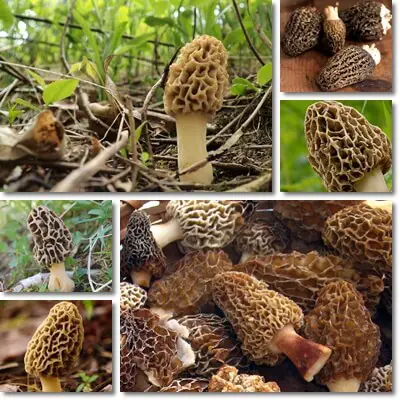Morels are edible mushrooms belonging to the Morchella genus. They are quite a peculiar-looking fungus, with honeycomb-like, conical caps and come in a range of colors, from cream to grey to brown to black. Listed as one of the tastiest mushrooms and a culinary delicacy, they are not meant to be eaten raw and must be cooked to reduce the risks for gastrointestinal upset and other side effects.
In terms of nutrition, morels are one of the best dietary source of vitamin D, but also copper, iron and manganese and a good source of B vitamins, especially vitamin B3. Studies show they have antioxidant, antimicrobial, antifungal, hepatoprotective and immune system enhancing properties and hold benefits for energy metabolism, fertility, bones and muscles.

When are morels in season?
True morels are in season in spring, usually April through May, sometimes up until June, although some species or morels are known to appear in autumn or winter. Some years, depending on weather variations and other factors (temperature, amount of rainfall, sunshine, region etc.), morel season may extend well into July or even late August. Anyway, these particular mushrooms have a limited season, which factors into their high selling price.
Why are morels so expensive?
Morels are a delicacy among mushrooms, and have a limited harvesting season, both reasonable explanations for why they are so expensive. Because they are mostly sourced from the wild, their selling price goes up every step along the chain of distribution, from the mushroom forager to the distributor to the restaurant serving them in a dish.
Also, morels are not easy to find so morel sightings are something of a trade secret that is extremely well kept. Because they are a delicacy and thus increasingly sought-after, most mushroom foragers keep good morel spots to themselves. Lastly, the supply never really meets the demand for them, even with rumors commercial farming of the species may soon be possible. All of these aspects contribute to the rather peppery selling prices for morel mushrooms.
What do morels look like?
The above-ground part of a morel is made up of a stem or stalk and a more unusual looking cap. The cap is often conical in shape (looks like a sort of a simplified fir tree design), but can also be more rounded or bulbous as well. What’s most interesting about the mushroom’s appearance is its honey comb-like appearance: an imperfect structure of vertical and more or less horizontal ridges and pits, remotely reminiscent of a honeycomb. In some species, the vertical ridges running from top to the bottom are the most prominent feature, sometimes also standing out as having a contrasting color to the pits.
Depending on the species, the pits may be either flat or deep, broad or narrow, more or less elongated. The cap can be soft and smooth, almost velvety to the feel, or covered with fine, matted hairs. The stem is either slender-looking and cylindrical or bulkier and club-shaped, usually more swollen at the base.
Depending on the species, cap color in morels may range from cream to light grey to yellowish or orange-brown, dark brown, dark grey and even black. The cap may be one color or more, with the ridges being a different color from the pits. Also, morels change color as they mature, usually becoming darker.
The stem is usually either whitish, tan or light brown and is either smooth or has fine, whitish or light brown grain-like structures on its surface. On the inside, the entire mushroom is hollow, from the base of the stem to the top of the cap, which is a distinguishing feature of true morels. Lastly, the mushrooms vary in size greatly, from a couple of centimeters to over 15-20 centimeters measured from the base of the stem to the top of the cap.
Morels look-alikes
There are actually dozens of more or less similar-looking morel species, not to mention inedible or poisonous look-alikes commonly known as ‘false morels‘. Verpa bohemica, Verpa conica and Gyromitra mushrooms are close look-alikes which are listed as both edible (if properly cooked) and inedible/poisonous mushrooms. Some of the similar-looking species are sources of toxins such as gyromitrin that elicit side effects for the gastrointestinal, nervous and muscular systems with potentially long-lasting effects.

What do morels taste like?
To some, they have a typical mushroom taste, a little more pronounced, more flavorful compared to white button or portobello mushrooms. A lot of people however find morels a culinary delicacy and feel they taste downright exquisite (cooked, of course). More exactly, morels have a pleasant, but mild mushroom-like taste with savory woodsy notes and faint nutty, meaty flavors. The hollow interior offers a unique culinary experience. They are available fresh, in season, frozen and dried off-season. Morel season starts in spring, April-May, and depending on the species, region and yearly weather variations, may last till late July or late August.
How to prepare and cook morels
True morels are edible mushrooms, but should only be eaten cooked. It is presumed that eating them raw or undercooked can cause gastrointestinal upset, intoxication symptoms or more serious side effects as a result of currently unidentified toxins. Fresh morels are best eaten within a week of picking (tops!).
Prior to cooking, they should be brushed and rinsed with cold water to remove any dirt or debris, then dried on a paper towel and cut lengthwise, unless they are really small, in which case they can be cooked whole. For the best taste experience, they are best sautéed in butter for 5-10 minutes and paired with garlic, onions, salt, pepper. They are great stir-fried, added to soups, ravioli or tortellini fillings, risotto or meat dishes.
How much do morels sell for?
As a culinary delicacy, fresh morels can easily sell for 15-20 dollars a pound at a farmer’s market, when in season. Naturally, the price goes up if you’re having them at a restaurant, in which case their price varies depending on the dish they’re added to. In addition to farmers’ markets, you can buy fresh or dried morels in some supermarkets, health food stores or online, depending on where you live and whether or not where you live is a morel place.
Nutritional information
Morels nutrition facts per 100 grams
- Energy: 31 kcal (kilocalories)
- Protein: 3.1 g
- Fat: <0.6 g
- Carbohydrates: 5.1 g
- Dietary fiber: 2.8 g
- Sugars: 0.6 g
- Calcium: 42 mg
- Copper: 0.625 mg/626 mcg (micrograms)
- Iron: 12.18 mg
- Magnesium: 19 mg
- Manganese: 0.587 mg
- Phosphorus: 194 mg
- Potassium: 411 mg
- Selenium: trace amounts
- Sodium: 21 mg
- Zinc: 2 mg
- Vitamin B1: 0.069 mg
- Vitamin B2: 0.205 mg
- Vitamin B3: 2.252 mg
- Vitamin B6: 0.136 mg
- Vitamin B9 (folate): trace amounts
- Vitamin C: –
- Vitamin D2: 5.1 mcg
- Vitamin A: 0 mcg
- Vitamin K: unknown
What are the benefits of eating morels?
The health benefits of morels are a direct result of their nutritional content as well as their content of unique biologically active elements with antimicrobial and immune system-modulating properties. Eating morels contributes to better overall health and beneficial effects include:
High vitamin D content with benefits for immunity
High in vitamin D2, morels stimulate the immune system, improve mood and benefit mental health, contribute to stronger bones as well as boost female fertility, helping improve conception rates and pregnancy outcomes. A serving of 100 g of the fresh mushrooms provides 5.1 mcg of vitamin D2 out of a recommended daily intake, RDI, of 15 mcg, accounting for about a third of daily requirements.
High iron content with benefits for fatigue
An incredible source of iron, morels restore vitality, boost energy levels and help combat fatigue, muscle weakness, apathy and low mood caused by anemia. A serving of 100 g provides 12.18 mg of iron out of a daily recommended intake of 18 mg, accounting for over 60% or 2/3 of daily needs.
High copper content with antiaging benefits
Morels are an excellent natural source of copper. The mineral copper is a co-factor for the superoxide dismutase enzyme and holds important antioxidant properties. Meeting daily requirements holds benefits for the nervous system, supports normal immune system function, helping maintain normal levels of certain white blood cells, as well as helps regulate blood sugar metabolism. One 100 g serving provides over 60% of daily requirements of copper.
Good manganese content with benefits for fertility
Morels are a naturally generous source of manganese. Eating 100 g of morel mushrooms provides around 25% of the daily requirements of manganese for adult men and around 30% for adult women. Manganese is a co-factor for the superoxide dismutase enzyme and holds important antioxidant properties.
The mineral is found in brain and spinal cord cells and is vital for female and male fertility. In women, manganese from bananas helps with ovulation. According to research, male reproductive cells are ‘critically dependent on Manganese for motility.’ It has been postulated that the decrease in male fertility can be explained, at least in part, by manganese deficiency in the diet (source).
Good content of phosphorus, good for bones and teeth
With over 30% of the recommended daily intake of vitamin D and over 27% of phosphorus, and smaller amounts of both calcium and magnesium, morels actively contribute to maintaining strong bones and teeth. Phosphorus from morels is involved in hormonal processes that regulate bone formation, and also protects and maintains tooth enamel. Vitamin D in morels works closely with phosphorus in regulating both phosphorus and calcium metabolism. Lastly, the small amounts of calcium and magnesium go into physically building bones and teeth.
Good source of vitamin B3 for high cholesterol
Morels provide good amounts of vitamin B3 for lowering high LDL cholesterol and triglyceride levels. Studies show vitamin B3 holds benefits for HDL which is the good kind of cholesterol. More exactly, it help raise HDL (good) cholesterol levels. 100 g of the mushroom species provides 16% of the daily requirements of vitamin B3 for adult women and 14% for men.
Other benefits of morels
- Hepatoprotective properties, restoring antioxidant levels in the liver from Morchella esculenta mycelium.
- Extracts of Morchella esculenta hold antifungal properties against A. fumigates.
- Extracts of the mushroom exhibit antimicrobial activity against E. coli.
- Immuno-modulating and anti-inflammatory properties of polysaccharides from Morchella angusticeps.
- Benefits for skin, nervous system and energy metabolism from B vitamins.
- Blood pressure-lowering properties thanks to a good potassium content (9% of daily requirements in a serving of 100 g) and modest magnesium levels.
- Low in calories and fat, good food for healthy weight loss.
What are the side effects of eating morels?
Gastrointestinal upset
Eating raw or undercooked morels can result in gastrointestinal upset with symptoms such as nausea, vomiting sensation, abdominal cramps, loose stools or diarrhea. Toxins responsible for such side effects are usually destroyed by cooking heat. However, some people may still experience them even with the cooked mushrooms.
Potential for allergic reactions
Like all foods, morels too have the potential to cause allergic reactions which can progress to anaphylactic shock, which is a medical emergency. Allergic response are more likely in people with other food allergies, especially other mushroom allergies. Avoid eating morels in all forms and preparations if you know or suspect your are allergic to them.
Source of heavy metals and other contaminants
Given they are currently sourced almost exclusively from the wild, morels take up nutrients as well as contaminants from the soil they grow in. Anything from lead, arsenic, mercury and aluminum to pesticides and herbicides can accumulate in the mushrooms if the soil they grow in is contaminated. For this reason, avoid foraging mushrooms from active or abandoned industrial areas, near factories of any kind, roadsides or from orchards or agricultural areas that don’t rely on organic agricultural practices.
